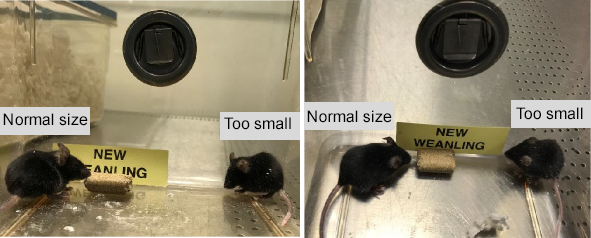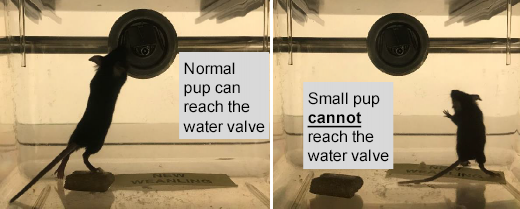Breadcrumb
- Home
- Office of Animal Resources
- Animal Health and Care
- Investigator guidance for monitoring and managing new weanling mice
Investigator guidance for monitoring and managing new weanling mice
Main navigation
Please follow this link to find the new procedures.
IACUC Guidelines:
New Weanling Procedure for Labs
Guidelines: The IACUC has provided a set of guidance documents (Policies, Guidelines, and Informational Sheets) for use when planning animal procedures at the University of Iowa. An exception to a Guideline must be described and justified in the Animal Protocol and approved during the normal review process.
Purpose: This document provides guidance to aid laboratory staff in required and recommended practices for the care of new weanling mice. As a reminder, proper rodent breeding management requires not only breeder pair evaluation, dating of litter births and proper weaning practices, but includes care in the post-weaning period, a time of high stress for young animals. This includes involvement up to 5-6 weeks of age for most mouse strains, sometimes longer for genetically modified lines. Failure to perform proper breeding management steps may result in OAR involvement and fees for your lab.
For all new weanlings, follow the steps below:
Required
- Identify the litter(s) to be weaned and determine the number of males and females present.
- Male mice from different litters can only be combined at the time of weaning (i.e., when separated from the breeding cage), to prevent fighting due to established social hierarchies once the cage is setup. See IACUC Policy on Housing of Social Species.
- Fill out the “Date Rec’d” line on the cage card as the date you weaned the mice.
- Place a yellow “New Weanling” tag on the cage cardholder.
- Place 2 pellets of feed on the cage floor.
- Prime the water valve

To prime the water valve press down (do not press in) on the small metal piece in the center of the valve with your gloved finger until water is released before placing the cage on the rack. This leaves some water on the valve and teaches the mice where the water is.
- If you feel the valve is not working, notify a facility supervisor.
Recommended
- Monitor animals daily for 3-5 days post-weaning. If animals are showing signs of dehydration or not thriving, please notify a caretaker or veterinary staff. (see page 3 for contact emails).
- Continue priming the water valve every day for 7 days (day of weaning and 6 additional days).
If the new weanlings are small, follow the steps below:
Required
- If possible, delay weaning:
- Are the pups younger than day 21? You may delay weaning up to day 24 if there is not an additional litter in the cage. This gives the mice several additional days to grow.
- You may request to delay weaning longer by placing the blue “Small Pup” tag (a veterinary technician will check these animal
- If you cannot delay weaning, follow all steps above AND:
- Add additional bedding from a clean cage until bedding is within 1 cm of the bottom of the water grommet.
- NOTE: DO NOT ADD an entire extra cage of bedding as it makes it very difficult to visualize the pups in the cage and may cause water to leak from the water valve into the bedding.
- Add a blue “Small Pup” card directly behind the New Weanling card.
- Add additional bedding from a clean cage until bedding is within 1 cm of the bottom of the water grommet.
- If small weanlings are an expected phenotype, this must be added to your Animal Protocol.
Recommended
- Monitor health of new weanlings daily for the first 14 days.
- Provide NapaNectar or DietGel 31M at the front of the cage.
- Labs should obtain their own supply of NapaNectar/DietGel if mouse strains consistently need this support.

If weanlings are small and sick/rough/hunched or dehydrated, they need to be evaluated as soon as possible by veterinary staff:
- During business hours (7:00am-3:30pm): Notify a caretaker/supervisor of the room and location.
- After hours/weekends/holidays: Contact the veterinary technician on-call (see on-call information posted at the animal facility or OAR website)
NOTE: any mouse strain which routinely requires supportive care for phenotype/strain reasons should be described in the Animal Protocol. Napa Nectar for hydration or Gel Diet for soft nutrition are recommended for animals which require supportive water access. If you have questions regarding the use of these products, please contact your facility supervisor or veterinarian.
Are your new weanlings small?
Example of 22 day-old mouse pups, one which is acceptable size and one which is too small to thrive without assistance.




EXAMPLES: New Weanling Cages and Cages with Small New Weanlings

How to Contact Animal Husbandry via email:
oar-husbandry-medlabs@uiowa.edu,(link sends e-mail) oar-husbandry-barrier@uiowa.edu,(link sends e-mail) oar-husbandry-bsb@uiowa.edu(link sends e-mail), oar-husbandry-PBDB-Nonbarrier@uiowa.edu,(link sends e-mail) oar-husbandry-psych-bio@uiowa.edu(link sends e-mail)
How to Contact Veterinary Technicians for a non-emergency concerns via email:
oar-health-medlabs@uiowa.edu,(link sends e-mail) oar-health-barrier@uiowa.edu,(link sends e-mail) oar-health-PBDB-Nonbarrier@uiowa.edu,(link sends e-mail) oar-health-bsb@uiowa.edu,(link sends e-mail) oar-health-psychology-biology@uiowa.edu(link sends e-mail)
Last reviewed by the IACUC 10/8/2025